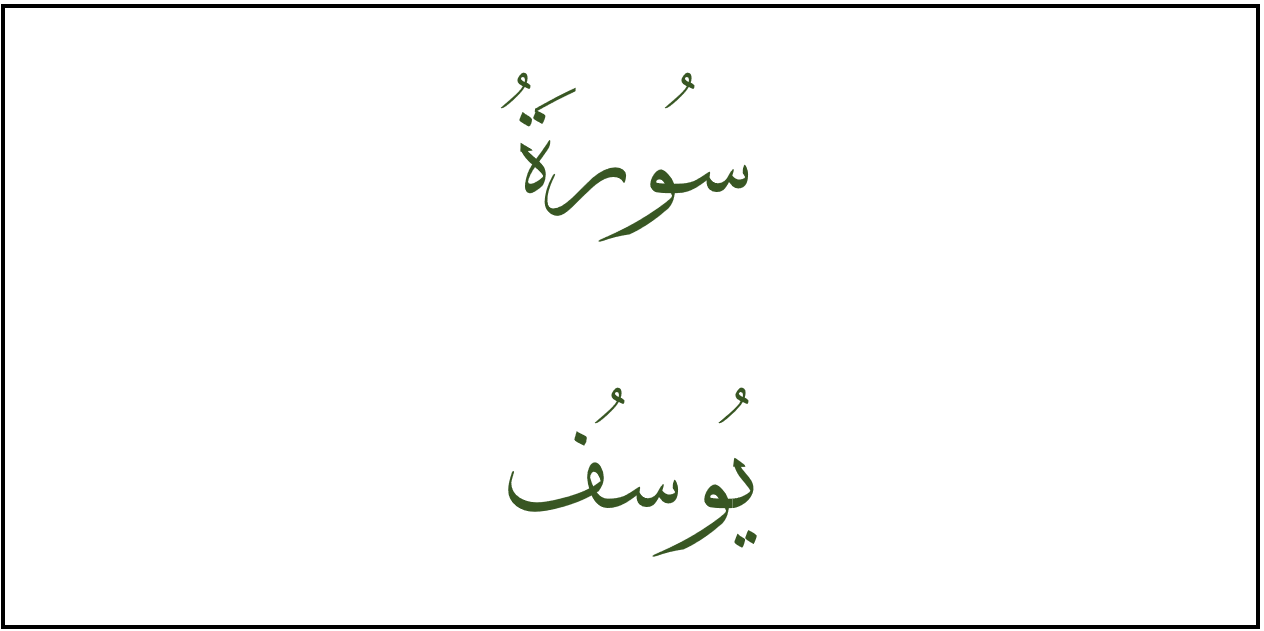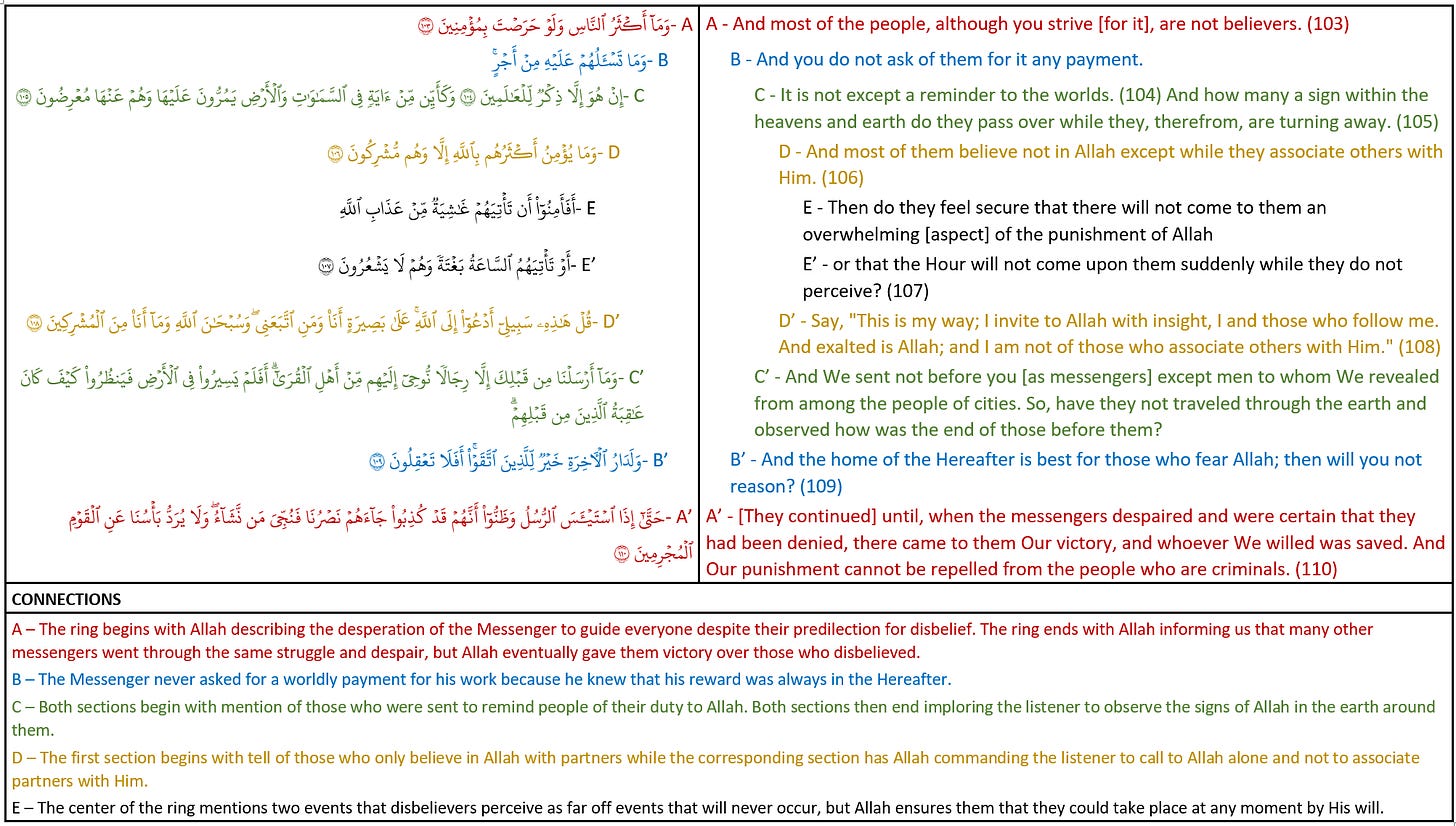Though we have already looked at Sūrah Yūsuf twice (here and here), there continues to be new research into its amazing structure.
This write-up builds off of the second post on this sūrah, Sūrah Yūsuf - Revisited. In particular, we will look at a relationship that wasn’t given much attention to then; the parallels between the Preface and Conclusion.
As a reminder, here is how the sūrah was shown to be organized overall:
When comparing the [A] - Preface and [A’] - Conclusion, it appears the subject matter forms its own ring structure as shown below:
Connections
A1/A1’
The sūrah begins and ends with mention of the Quran’s heavenly origins. “Alif, Lām, Rā’” are letters whose meaning is only known with Allah ﷻ. This is immediately followed by “Those are the signs,” as if to say that the source of the Quran is far away (with Allah ﷻ) and not the Messenger ﷺ. He ﷻ also tells us that the Quran is meant to “clarify” our affairs. Finally, Allah ﷻ mentions that this is an “Arabic recital” (i.e. something spoken) so that we may “understand”.
This matches with the end of the sūrah wherein Allah ﷻ tells us that the Quran is not “invented speech” by the Messenger ﷺ, and is actually a “confirmation” and “detailed explanation” of what has been revealed before. Finally, Allah ﷻ ends the sūrah mentioning “guidance and mercy for people who seek faith,” which is a necessary outcome for one who “understands” what is being conveyed in the Quran.
A2/A2’
Both sections share the usage of “qaṣaṣ (story)” as a way of reminding the audience that Him narrating the “best of stories” wasn’t for entertainment value, but rather as a “lesson for those of sound mind”. After going through the sūrah in a reflective manner, one should realize what made it "the best of stories”.
A3/A3’
Finally, this ring centers on the Messenger’s role in conveying this message. The Quran was revealed to him, which made him aware of events he was absent from, as well as from the unseen, so that we may learn lessons.
If you looked closely above, you may have noticed that there is a significant amount of the [A’] - Conclusion omitted from the analysis. We still need to discuss āyāt 103-110. First we will discuss its placement in the sūrah and then we’ll analyze the structure of the section on its own.
Placement
Āyāt 103-110 can be summarized as a commentary on the audience of the Messenger ﷺ (i.e., the Quraysh) and what he should do in lieu of that audience. At first glance, it appears that the passage is out of place as it doesn’t have an apparent connection to the text at the beginning nor with the text around it. However, as we’ve been learning, ring structure is but one of many ways the Quran may be organized. It’s also important to recognize the linear coherence of a sūrah as the immediate context can tell us a great deal about the placement of an āyah or set of āyāt.
The Quraysh - and Arabs at the time - were descendants of Ishmael, which represent the opposite branch of the Abrahamic family tree. While the sons of Jacob (i.e. the descendants of Isaac) plotted against Joseph, similarly, the Quraysh (i.e., the descendants of Ishmael) were conspiring in secret against the Messenger ﷺ. And like the sons of Jacob thought that their strength came from their numbers, the Quraysh used their superior forces to oppress the burgeoning Muslim community.
And just as Joseph was informed that he’d get back at his brothers “wa hum la yash’urūn (and they won’t realize it)”, the Messenger ﷺ is also being told that he and his followers will overtake the Quraysh “wa hum la yash’urūn (and they won’t realize it)”.
There are many, many, many other parallels between the life of Joseph and the life of the Messenger ﷺ, which makes the context of this passage make all the more sense when one considers the āyāt immediately before and after it:
That is from the news of the unseen which We reveal, [O Muhammad], to you. And you were not with them when they put together their plan while they conspired. (102)
Passage under consideration; Audience of the Messenger (103-110)
There was certainly in their stories a lesson for those of understanding. Never was the Qur'an a narration invented, but a confirmation of what was before it and a detailed explanation of all things and guidance and mercy for a people who believe. (111)
Structure
In addition to its linear coherence within the Conclusion, it appears that āyāt 103-110 can be arranged in its own ring structure as shown below.
والله أعلم - And Allah knows best
Sources
Khan, Nouman. “S. Yusuf Coherence Session 1: The First and Last Passages” YouTube, uploaded by Bayyinah Institute, Nov 24, 2020, https://youtu.be/Ou1spMS1Msk
Khan, Nouman. “S. Yusuf Coherence Session 2: 103-110” YouTube, uploaded by Bayyinah Institute, Nov 30, 2020, https://youtu.be/ewXW1ncl0iY
The ring structure of āyāt 103-110 is from personal notes and research






